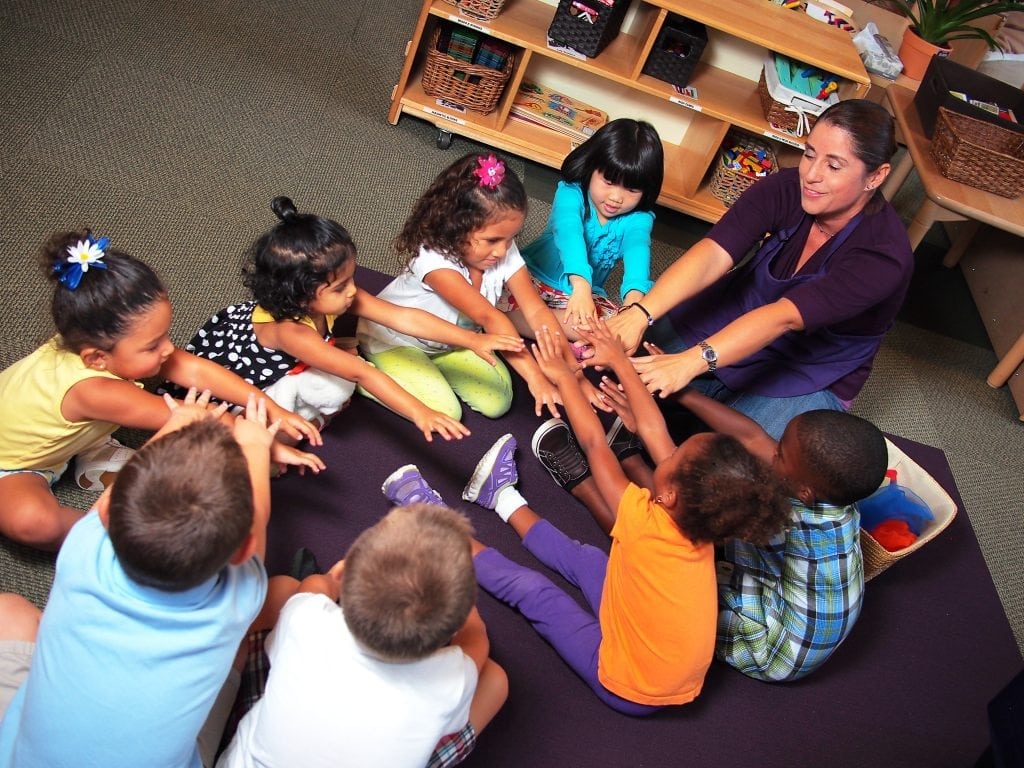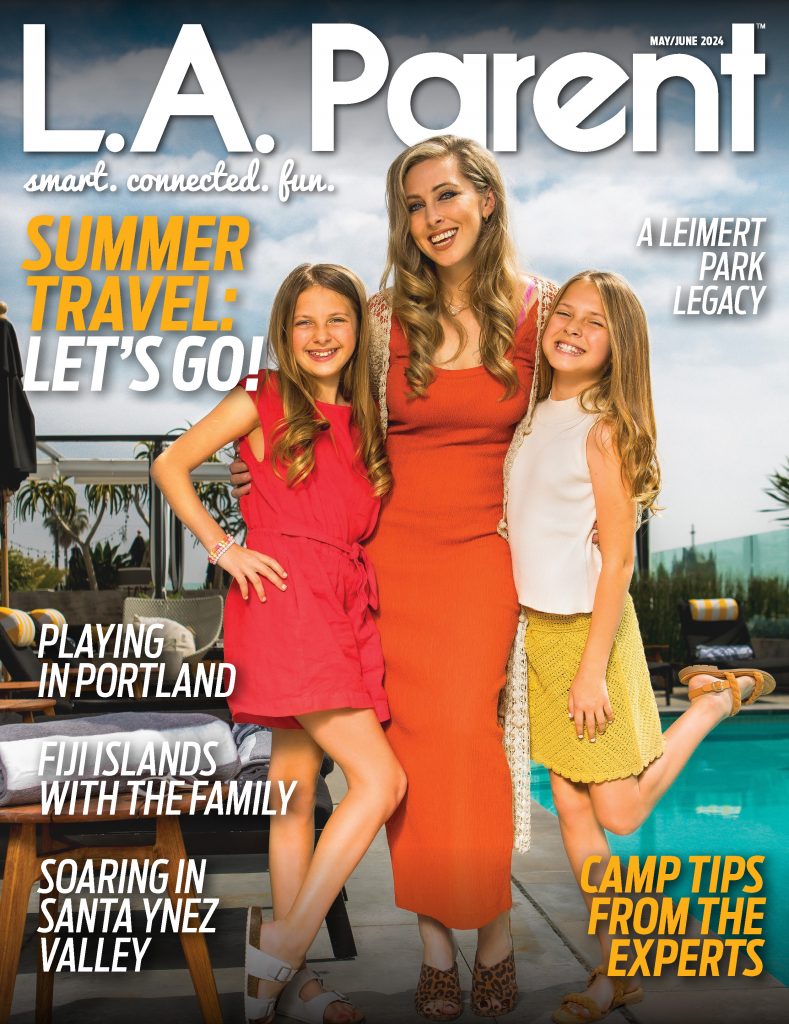
When a rabbit gave birth at Pierce College Child Development Center, teachers turned the experience into a lesson for the preschoolers. PHOTO COURTESY PIERCE COLLEGE
Search out the best play-based and academic elements to find the right fit for your child.
When my daughter, Mirae, was 3, she came home from preschool one day raving about baby rabbits. A rabbit had given birth and burrowed her offspring in the dirt just under the swing set at Mirae’s preschool, Pierce College Child Development Center in Woodland Hills. A child found the burrow, and the adventure began.
The teachers at this play-based preschool turned the discovery into an opportunity for learning. They first asked the children what they should do to protect the baby rabbits from predators. The children suggested making “keep out” signs. They each created signs and staked them on wooden sticks around the burrow. Day after day, they observed, left food for and looked after the rabbits. They counted them, spelled out “rabbit” with magnetic letters, read books about rabbits, drew pictures in their journals about their experience and used measuring tape to see how deep the burrow was after the momma rabbit had removed her babies.
Preschool these days is much more than a place to learn letters, numbers and how to sit quietly for “circle time.” Preschools follow a range of learning philosophies, with most incorporating a mix of play-based and academic learning. The key to a great preschool experience for your child is finding the mix that fits your child’s personality and learning style.
Letting Children Lead
At preschools that define themselves as more play-based, teachers observe the interests of the children in their classrooms and choose study topics that follow those interests. They then introduce academic concepts that include hands-on experiences based on those topics. This may mean that lessons differ from day to day and week to week, and that children in different classrooms in the same preschool have different learning experiences. “Play-based preschools allow children and teachers the opportunity to explore, investigate and comprehend a topic together,” says Astrid Feist, program support specialist at Los Angeles Universal Preschool (LAUP).
Proponents of play-based preschools say child-led activities are more meaningful to young children. “Learning only takes place when it’s interesting and relevant,” says Phyllis Schneider, director of Pierce College Child Development Center, who credits child psychologist David Elkind’s research for her bent toward play-based learning. She says the children’s discovery of the rabbits allowed for learning that would stick better than a teacher-led lesson.
Some experts also consider play-based learning as more developmentally appropriate for young brains. “If you incorporate smell, sight, sound, taste and touch as well as movement, that’s going to ce

Astrid Feist, program support specialist at Los Angeles Universal Preschool (LAUP), says that if your child’s preschool program focuses heavily on academics, you can provide balance by making time for child-directed playdates at home. PHOTO COURTESY LAUP
ment that experience in the child’s brain [better] than just telling them,” says Melissa Brisbois, a Pierce College preschool teacher.
Finally, play-based learning also allows children to flex some mental muscles that a worksheet just won’t exercise. “Play allows for opportunities to develop in areas such as creativity and problem solving,” says Carrie Reed, owner of The Toddlers’ Clubhouse and Preschool in Reseda, where the curriculum mixes teacher-led and child-led activities.
Benefits of Structure and Progress
Schools that focus more on teacher-led skill building are considered academic preschools. “In an academic classroom, learning is driven by the teacher,” says Feist. Expect worksheets, flash cards and other 2D work in this type of environment. You may also notice a thematic curriculum that follows a sequence of activities and involves drills and practice of progressive concepts. Letters of the day, calendar work and introduction of successive numbers each week all indicate an academic program. “There is a right or wrong answer and a focus on memorization,” says Feist.
With all the buzz around kindergarten readiness, the clearer picture academic-based programs offer of students’ writing, reading and math skills is comforting to many parents. Teachers in academic preschools regularly assess abilities in those subjects, so parents will know where their child is proficient and where skills need to improve. If you want to know whether your child knows all the sounds of the alphabet, a teacher-led program will test your child by having them write each letter after hearing the associated sound.
Children who have been exposed to teacher-led curricula might also transition more easily into traditional academic-focused kindergarten, where practice in testing, worksheets and flash cards will give them an edge. The more structured environment in academic-focused preschool programs can also be more comfortable for children who thrive on routine. In an academic preschool, there is generally a set time to do certain subjects each day, which gives children predictability they may enjoy.
Finding the Right Mix
Pasadena mom Jean Lee visited a highly selective school that promotes early reading, but ultimately chose Cottage Co-op Nursery School for her daughter. She wants her child to succeed in kindergarten, so the school’s focus on “no lines and no paperwork” felt like a bit of a gamble. But she felt her daughter would fare better with more engaging play experiences. “You want your child to be ready for kindergarten, and you see a child reading early, so you second-guess play-based learning,” says Lee.

In a play-based preschool program, shovels floating in a bucket of water can teach children about color, counting and science. PHOTO COURTESY COTTAGE CO-OP PRESCHOOL
And Cottage Co-op Director Sahar Farmanesh contends that academics are still present. “A bucket of water with shovels can be a science experiment,” she says. “Will the shovels float or sink? It can also be a lesson in colors as well as a counting exercise. The aspects of play that help develop academic skills are easy to incorporate without the need for paper and pencil. The best preschools will help children learn academic skills in the course of play.”
In the same way that play-based programs should be able to demonstrate academic skill building, academic preschools should have opportunities for child-led play. “Direct instruction can be a useful tool as long as it is developmentally appropriate and engaging for the child,” says Reed. “I also strongly believe that play is the context in which children develop and learn.” Ideally, parents choosing a preschool should search out the best mix of child-led and teacher-led activities.
If the program you choose leans too heavily toward academics or play, you might have to bridge the gap at home. Schneider says a parent at her preschool was discouraged because her child didn’t know certain sight words after finishing their pre-k program. She gave the mom examples of how to develop academic skills at home. “Put [children] in charge of the grocery list,” Schneider says. “When you’re going shopping, make a short list and tell them it is your job to find cereal, milk, apples and cheese. In this way, the child can practice printing, counting and reading in a way that is interesting and relevant to your family.”
If you choose a more structured learning environment for your child, be sure they have ample time for free play and exploration at home. “If your child is in an academic program, the child’s schedule should allow for playdates that involve child-led cooperative play with peers,” says Feist. “Be a guide, but do not lead the interaction.”
Eyes On the Prize
In the big picture of what preschool means for your child, play and academics both have their place. “I think it’s a false dichotomy to talk about play and academics [separately],” says Tina Payne Bryson, co-author of “The Whole-Brain Child” and executive director of The Center for Connection counseling center in Pasadena. “In preschool, academic skills and what they learn in play are actually very much the same thing. Play is children’s work and the way in which they learn cognitive skills, planning ahead, organizing thoughts, expressing themselves. Those are fundamental academic skills that allow them to succeed.”
Bryson says the most important thing at any preschool, no matter the program, is that children are learning:
- What it’s like to be at school
- How to work with and play with other kids
- How to advocate for themselves
- How to bounce back when they don’t get their own way and
- How to be flexible and handle emotions without their parent present.
“Those are the most important things, and that can happen at a wide variety of most schools,” Bryson says.
So conduct your search with an eye toward finding a preschool environment that mixes child-centered and teacher-led activities in a way that best matches your child’s learning style. And once you choose, stay engaged so that you can support your child and provide balance at home, and help your child develop a lifelong love of learning.
Carolyn Richardson is the mom of a kindergartner and twin preschoolers, and is Assistant Editor at L.A. Parent.









































